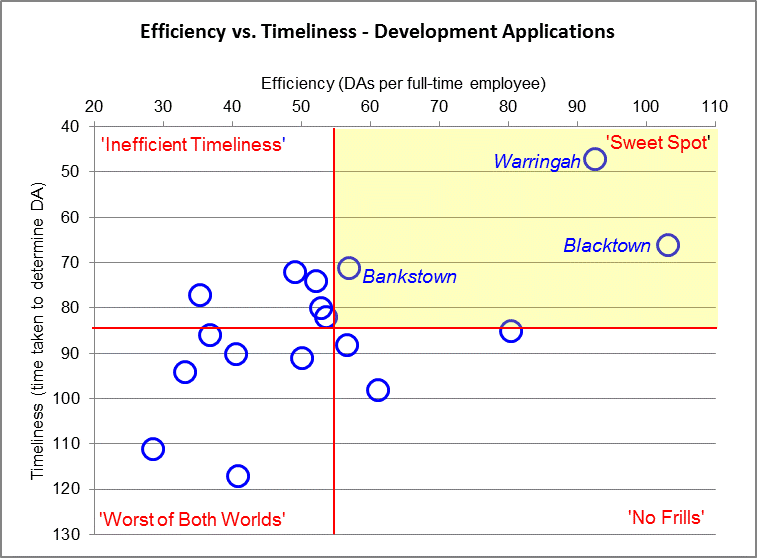FASTER AND LEANER: A SAMPLER FROM LOCAL GOVERNMENT
Can local councils process their development applications (DAs) faster?
And can they do it with the same number of staff? Or less?
These are the kinds of issues with which all service organisations grapple.
The release earlier this year of data comparing development performance across all of NSW’s 152 local councils1 provides a way into this issue.
The data allows us to compare councils to identify observed best practice. From there, councils can aim to emulate their best practice peers; they can also develop improvement programs to streamline their services and gain greater value from what they already have.
Efficiency vs. Timeliness?
The graph below shows the story for a subset of Sydney councils. The horizontal axis plots how efficient each council is (the further to the right, the more efficient) while the vertical axis plots each council’s timeliness in determining DAs (the closer to the top, the faster the council is in turning DAs around).

source: adapted from NSW Department of Planning & Infrastructure, 2013, Local Development Performance Monitoring 2011-2012. Data are for NSW urban metropolitan developed councils with populations ranging from 70,000 up to over 120,000 (ie. DLG code 3).
We can split each axis into two: high and low timeliness, and high and low efficiency, which gives 4 (2 x 2) combinations:
- the top right-hand quadrant has the best combination: timeliness coupled with efficiency; this section, which is shaded yellow, is labelled ‘The Sweet Spot’
- the top left-hand quadrant contains councils that were timely in dealing with DAs, but were not efficient in handling those DAs (‘Inefficient Timeliness’)
- the bottom right-hand quadrant contains councils that were efficient, but not timely (‘No Frills’)
- the bottom left-hand section is the one to avoid: councils that were neither efficient or timely (‘Worst of Both Worlds’).
No Trade-Off
Warringah and Blacktown were the star performers combining both efficiency and timeliness in dealing with DAs. Bankstown also fell into The Sweet Spot. (I’ve not identified the other 14 councils…).
What’s interesting to note here is that there’s no trade-off between timeliness and efficiency: higher levels of efficiency (more DAs being dealt with per staff member) are associated with timeliness, and vice versa. In other words, you don’t need more staff to process DAs more quickly.
What is to be Done?
All of which is fine, but raises the question about what councils can do to improve their performance relative to the high performers.
Here's how I would go about it:
• map the process for determining DAs in your council
• identify the slowest parts of the DA process, with a particular eye to those displaying complexity, overprocessing, waiting and downtime, and errors necessitating rework
• use analytical tools such as 5 Whys and Pareto charts to uncover the causes of these problems
• match appropriate solutions to identified problems; for example unbundle complex tasks; redistribute staff or workload where there are mismatches between these; and streamline resource-intensive processes
• pilot and implement these solutions; embed the changed processes in operating procedures, and review after implementation.I offer training in these performance improvement techniques, with the use of simulation-based learning and development methods. These have yielded great results; for example, in applying the training to map an IT process, a government department was able to reduce turnaround time by 25 days: a 31 percent improvement. Please phone me on 0414 383 374 or email info@mcarmanconsulting.com to arrange this training for your organisation.
A 6,800 Day Reduction in Turnaround Time
The benefits of this type of improvement activity are real and not to be under-estimated.
For example, the council at the lower end of the No Frills quadrant took 98 days on average to determine a DA. If this council implemented process improvements that moved its timeliness to the outer edge of the Sweet Spot (ie. to 84 days to determine a DA) this 14 day reduction, multiplied by the nearly 500 DAs processed in a year by that council, would equate to a reduction in turnaround time of over 6,800 days across all DAs in a year.
Likewise, if the council leftmost in the Inefficient Timeliness quadrant increased efficiency from 35 DAs per employee to the threshold value of 54, the same number of staff would process an extra 590 DAs per year.
And these are only improvements that take councils to the outermost edge of the Sweet Spot – the benefits of moving closer to observed best practice are greater still.
Establishing actual and desired levels of performance, and utilising performance improvement techniques to attain the latter is a compelling proposition; all the more so when gains can be made across more than one dimension of performance, ie. both timeliness and efficiency.
* * *
Special Offer: For a free 20 minute consultation on your organisation’s performance please phone me on 0414 383 374 or email me at info@mcarmanconsulting.com before the end of July 2013. (Consultations will occur by phone for organisations outside the Sydney metro area).
With best regards,
Michael Carman
Director I Michael Carman Consulting
PO Box 686, Petersham NSW 2049 I M: 0414 383 374 I
Notes:
1. NSW Department of Planning & Infrastructure, 2013, Local Development Performance Monitoring 2011-2012.
© Michael Carman 2013
